

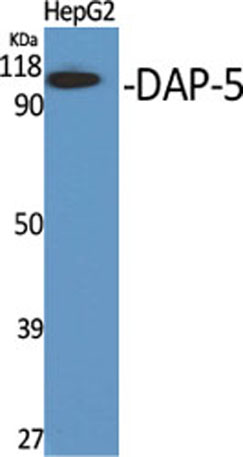
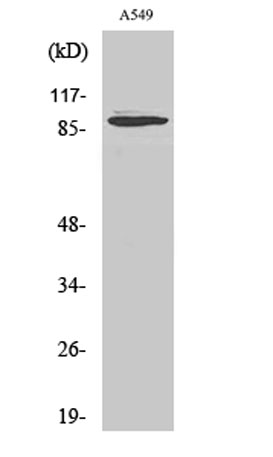
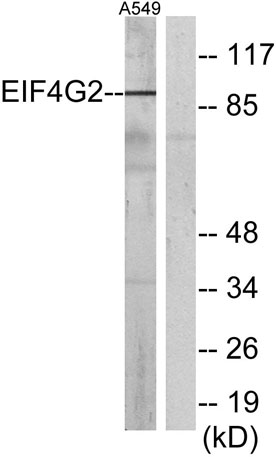
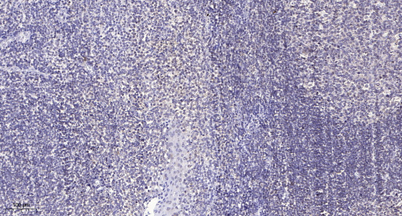
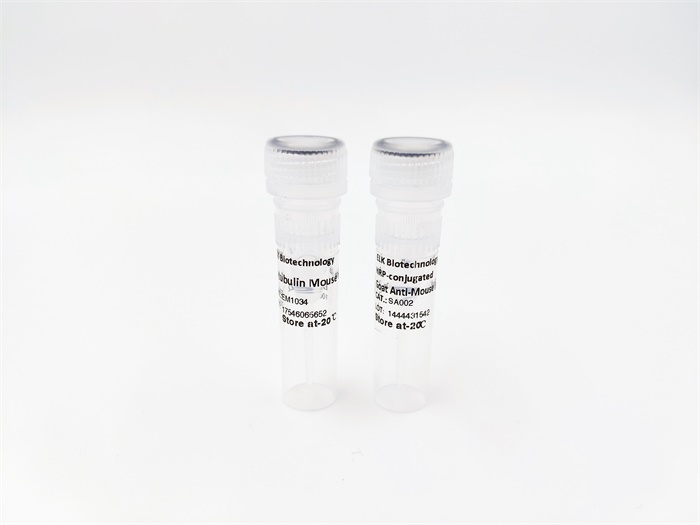



DAP-5 rabbit pAb
 One-click to copy product information
One-click to copy product information$148.00/50µL $248.00/100µL
| 50 µL | $148.00 |
| 100 µL | $248.00 |
Overview
| Product name: | DAP-5 rabbit pAb |
| Reactivity: | Human;Mouse |
| Alternative Names: | EIF4G2; DAP5; OK/SW-cl.75; Eukaryotic translation initiation factor 4 gamma 2; eIF-4-gamma 2; eIF-4G 2; eIF4G 2; Death-associated protein 5; DAP-5; p97 |
| Source: | Rabbit |
| Dilutions: | Western Blot: 1/500 - 1/2000. Immunohistochemistry: 1/100 - 1/300. Immunofluorescence: 1/200 - 1/1000. ELISA: 1/20000. Not yet tested in other applications. |
| Immunogen: | The antiserum was produced against synthesized peptide derived from human EIF4G2. AA range:41-90 |
| Storage: | -20°C/1 year |
| Clonality: | Polyclonal |
| Isotype: | IgG |
| Concentration: | 1 mg/ml |
| Observed Band: | 90kD |
| GeneID: | 1982 |
| Human Swiss-Prot No: | P78344 |
| Cellular localization: | cytosol,cell-cell adherens junction,membrane,eukaryotic translation initiation factor 4F complex,axon, |
| Background: | Translation initiation is mediated by specific recognition of the cap structure by eukaryotic translation initiation factor 4F (eIF4F), which is a cap binding protein complex that consists of three subunits: eIF4A, eIF4E and eIF4G. The protein encoded by this gene shares similarity with the C-terminal region of eIF4G that contains the binding sites for eIF4A and eIF3; eIF4G, in addition, contains a binding site for eIF4E at the N-terminus. Unlike eIF4G, which supports cap-dependent and independent translation, this gene product functions as a general repressor of translation by forming translationally inactive complexes. In vitro and in vivo studies indicate that translation of this mRNA initiates exclusively at a non-AUG (GUG) codon. Alternatively spliced transcript variants encoding different isoforms of this gene have been described. [provided by RefSeq, Jul 2008], |
-
 Western Blot analysis of various cells using DAP-5 Polyclonal Antibody
Western Blot analysis of various cells using DAP-5 Polyclonal Antibody -
 Western Blot analysis of A549 cells using DAP-5 Polyclonal Antibody
Western Blot analysis of A549 cells using DAP-5 Polyclonal Antibody -
 Western blot analysis of lysates from A549 cells, using EIF4G2 Antibody. The lane on the right is blocked with the synthesized peptide.
Western blot analysis of lysates from A549 cells, using EIF4G2 Antibody. The lane on the right is blocked with the synthesized peptide. -
 Immunohistochemical analysis of paraffin-embedded human tonsil. 1, Antibody was diluted at 1:200(4° overnight). 2, Tris-EDTA,pH9.0 was used for antigen retrieval. 3,Secondary antibody was diluted at 1:200(room temperature, 30min).
Immunohistochemical analysis of paraffin-embedded human tonsil. 1, Antibody was diluted at 1:200(4° overnight). 2, Tris-EDTA,pH9.0 was used for antigen retrieval. 3,Secondary antibody was diluted at 1:200(room temperature, 30min).

 Manual
Manual